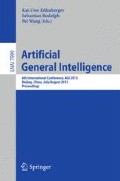Abstract
This paper proposes a cognitive architecture based on Kahneman’s dual process theory [1]. The long-term memory is modeled as a transparent neural network that develops autonomously by interacting with the environment. The working memory is modeled as a buffer containing nodes of the long-term memory. Computations are defined as processes in which working memory content is transformed according to rules that are stored in the long-term memory. In this architecture, symbolic and subsymbolic reasoning steps can be combined and resource-bounded computations can be defined ranging from formal proofs to association chains.
Access this chapter
Tax calculation will be finalised at checkout
Purchases are for personal use only
Preview
Unable to display preview. Download preview PDF.
References
Kahneman, D.: A perspective on judgment and choice: mapping bounded rationality. American Psychologist 58, 697 (2003)
Goertzel, B.: Perception processing for general intelligence: Bridging the symbolic/subsymbolic gap. In: Bach, J., Goertzel, B., Iklé, M. (eds.) AGI 2012. LNCS, vol. 7716, pp. 79–88. Springer, Heidelberg (2012)
Strannegård, C., Häggström, O., Wessberg, J., Balkenius, C.: Transparent neural networks: Integrating concept formation and reasoning. In: Bach, J., Goertzel, B., Iklé, M. (eds.) AGI 2012. LNCS, vol. 7716, pp. 302–311. Springer, Heidelberg (2012)
Strannegård, C., Ulfsbäcker, S., Hedqvist, D., Gärling, T.: Reasoning Processes in Propositional Logic. Journal of Logic, Language and Information 19(3), 283–314 (2010)
Strannegård, C., Engström, F., Nizamani, A.R., Rips, L.: Reasoning about truth in first-order logic. Journal of Logic, Language and Information, 1–23 (2013)
Strannegård, C., Amirghasemi, M., Ulfsbäcker, S.: An anthropomorphic method for number sequence problems. Cognitive Systems Research (2012)
Wood, R., Baxter, P., Belpaeme, T.: A review of long-term memory in natural and synthetic systems. Adaptive Behavior 20(2), 81–103 (2012)
Miller, G.: The magical number seven, plus or minus two: some limits on our capacity for processing information. Psychological Review 63(2), 81 (1956)
Cowan, N.: Working memory capacity. Psychology Press, New York (2005)
Baars, B., Gage, N.: Cognition, brain, and consciousness: Introduction to cognitive neuroscience. Academic Press (2010)
Wixted, J.: The psychology and neuroscience of forgetting. Annu. Rev. Psychol. 55, 235–269 (2004)
Ebbinghaus, H.: Memory: A contribution to experimental psychology. Number 3. Teachers college, Columbia university (1913)
Harrison, J.: Handbook of practical logic and automated reasoning. Cambridge University Press (2009)
Rumelhart, D., McClelland, J.: Parallel distributed processing: Psychological and biological models, vol. 2. The MIT Press (1986)
Pearl, J.: Probabilistic reasoning in intelligent systems: networks of plausible inference. Morgan Kaufmann (1988)
Hawkins, J., George, D.: Hierarchical temporal memory - concepts, theory, and terminology. Technical report, Numenta, Inc. (2006)
Hochreiter, S., Schmidhuber, J.: Long short-term memory. Neural Computation 9(8), 1735–1780 (1997)
Gärdenfors, P.: Conceptual Spaces. MIT Press (2000)
d’Avila Garcez, A.S., Lamb, L.C.: Cognitive algorithms and systems: Reasoning and knowledge representation. In: Cutsuridis, V., Hussain, A., Taylor, J.G. (eds.) Perception-Action Cycle. Springer Series in Cognitive and Neural Systems, pp. 573–600. Springer, New York (2011)
Laird, J., Newell, A., Rosenbloom, P.: Soar: An Architecture for General Intelligence. Artificial Intelligence 33(3), 1–64 (1987)
Anderson, J., Lebiere, C.: The atomic components of thought. Lawrence Erlbaum, Mahwah (1998)
Bach, J.: The MicroPsi agent architecture. In: Proceedings of ICCM-5, International Conference on Cognitive Modeling, Bamberg, Germany, pp. 15–20 (2003)
Sun, R.: The importance of cognitive architectures: An analysis based on Clarion. Journal of Experimental & Theoretical Artificial Intelligence 19(2), 159–193 (2007)
Gobet, F., Lane, P.C.: The CHREST architecture of cognition: the role of perception in general intelligence. Kitzelmann, E (2010)
Wang, P.: From nars to a thinking machine. In: Proceedings of the 2007 conference on Advances in Artificial General Intelligence: Concepts, Architectures and Algorithms: Proceedings of the AGI Workshop 2006, pp. 75–93. IOS Press, Amsterdam (2007)
Simon, H., Newell, A.: Human problem solving: The state of the theory in 1970. American Psychologist; American Psychologist 26(2), 145 (1971)
Huet, G.: Confluent reductions: Abstract properties and applications to term rewriting systems: Abstract properties and applications to term rewriting systems. Journal of the ACM (JACM) 27(4), 797–821 (1980)
Author information
Authors and Affiliations
Editor information
Editors and Affiliations
Rights and permissions
Copyright information
© 2013 Springer-Verlag Berlin Heidelberg
About this paper
Cite this paper
Strannegård, C., von Haugwitz, R., Wessberg, J., Balkenius, C. (2013). A Cognitive Architecture Based on Dual Process Theory. In: Kühnberger, KU., Rudolph, S., Wang, P. (eds) Artificial General Intelligence. AGI 2013. Lecture Notes in Computer Science(), vol 7999. Springer, Berlin, Heidelberg. https://doi.org/10.1007/978-3-642-39521-5_15
Download citation
DOI: https://doi.org/10.1007/978-3-642-39521-5_15
Publisher Name: Springer, Berlin, Heidelberg
Print ISBN: 978-3-642-39520-8
Online ISBN: 978-3-642-39521-5
eBook Packages: Computer ScienceComputer Science (R0)

